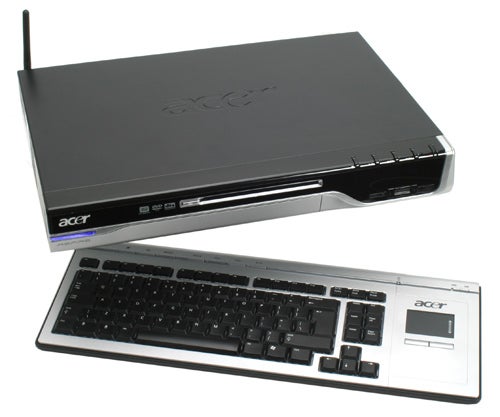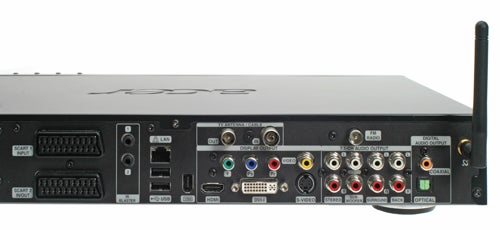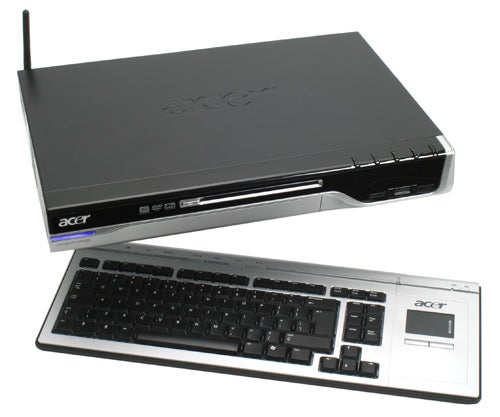Acer Aspire Idea 500 Media Center System Review
Acer Aspire Idea 500 Media Center System
Acer's Aspire Idea 500 is compact and well featured. Is this the Media Center system you're looking for.

Verdict
Key Specifications
- Review Price: £842.00
The name of this Acer Media Center system, the Idea 500, is actually very apt. Despite having been around for some years now, the Media Center platform is still a niche product and are yet to register on the radar of the average consumer. Recently I discovered that PC World is offering a home cinema installation service based on Media Center systems so with that kind of exposure things might change. Right now though, Media Center is still much more likely to be bought by the PC savvy consumer. That said, if you had the Acer Idea 500 under your TV, most people would probably have no idea that it was a PC.
The Idea is one of the sleekest Media Center systems I’ve seen. It’s about the size of an average DVD player though it does have a hint of 80’s VCR about it. This is mainly down to the rather retro two line dot matrix style LCD that displays ‘Welcome to the Aspire Idea’.
The DVD drive is a notebook style slot loading affair with an eject button on the left. To the right of this is are Stop, Play, Skip and Record buttons built into the curve of the chassis and there are also some buttons beneath the screen, which looks as if they’re for navigating. I say look, because try as I might I couldn’t get any of these buttons to actually do anything on our review sample. 
On the far left is a thin plastic strip that divides the top half and a large flap underneath. This strip is the power switch and lights up blue when the machine is powered on. Press it once or hit the power button on the Media Center remote and it starts to flash orange and the Acer will quickly drop into standby. You can also bring the system out of standby by pressing any button on the remote – crucial for that consumer electronics feel. That’s Viiv technology in action though there’s no corresponding sticker on the box.
Underneath the flap in the lower half you’ll find a wealth of connections split into two halves. There’s a card reader for both Compact Flash and another for MemoryStick, SD and xD – which is a very easy way of showing off the snaps on your TV. Next to this is a mini FireWire port.
On the other side there are two USB 2.0 ports, and composite and S-Video inputs along with phono stereo – the only use I can think for this is capturing from an old analogue camcorder, so I guess it’s worthwhile. There are also large phono hi-fi style microphone and headphone sockets. 
Looking round the rear you’ll find even more generous connectivity. Most notable of these is the HDMI port. This was the first time I’ve actually used HDMI and I was impressed by the simplicity – one cable and you get picture and sound – job done. The specs lists HDCP support, though we have no way of testing this yet. Next to the HDMI is a DVI port and there’s also component, composite, S-Video and SCART in and out – all bases covered. You also get a wide choice for audio output too. There’s a 7.1 analogue phono outputs, a coaxial output and an optical. I tested using the HDMI and connected without issue and got as good a picture as I could expect on the very average TV I was using to test with. I also tested over S-Video to a CRT TV. Obviously Media Center doesn’t look its best like this but it did work though I’ve seen steadier S-Video output from a dedicated nVidia 6200.
There also an antenna input and output for the two TV Tuners. These are hybrid, which should mean that you can pick up both analogue and digital signals. I say should as I could not get the Acer to detect any digital TV channels from the office TV connection at all.
The issue was definitely with the tuners as I connected a USB digital tuner that was had in the office and got a strong, clear picture. This meant we could only pick up the first four channels over analogue, and these looked frankly awful. This is a real shame and the dual tuners should have been a great feature. There’s an FM tuner as well and also two IR Blaster’s so you can in theory control up to two external set-top boxes.
The remaining connectivity is another two USB 2.0 ports, a Gigabit capable Ethernet port and finally a aerial in the corner for the integrated Wi-Fi. Unfortunately, the drivers weren’t installed on our review sample and while other drivers were available on the Asus web site the Wi-Fi drivers were not.
The hard disk is a full size 250GB Western Digital, which is only ok for a system like this – larger capacity drives are available. The processor is a T2300 Intel Core Duo chip, running at 1.66MHz – not super fast but good enough. There’s 1GB of RAM provided on two 512MB DIMMs. Both slots are filled but this isn’t’ the sort of system you’ll want to be opening up anyway. The graphics are provided by Intel and naturally are integrated. If this machine has a Blu-ray or an HD DVD drive, this combination of CPU and graphics might not be enough to playback the content but the fact is that it doesn’t so I guess it’s a moot point. 
Opening up the system I found that all of this is powered by a lowly 120W PSU. There are only two fans in the system, one on the PSU and one over the CPU heatsink, which helps to make it really quiet and room friendly.
Unlike many Media Center system’s which use a rather ugly external infra-red dongle for the remote and keyboard, Acer has integrated this into the front of the chassis. This means less clutter and easier set-up. The remote provided is a standard Media Center one, which does the job well. The keyboard looks rather conventional and there are some useful shortcut buttons at the top. There’s a notebook style trackpad and mouse buttons attached to the right hand side. The keyboard has slightly rattly keys but was up to the job. However, it bothered me for two reasons. Firstly, next to the styling of the system itself, the keyboard looks rather corporate. Also the trackpad is on the right, which wasn’t much help to me as a left hander. Obviously, Acer has to cater for the vast majority but I thought I’d mention it anyway.
Taking the Acer home one night and using it for watching some pre-recorded content I was pleased with the ease of set up, the quiet operation and the reasonable looks. However, the numerous issues I experienced while testing rather soured my view. Top of the list are the two tuners that just aren’t good enough. They couldn’t lock onto a digital signal, when an inexpensive USB tuner could. That’s not impressive and I’d be sending it back if I had planned on relying on it. The other issue was the missing Wi-Fi drivers and the buttons on the front that don’t do anything, though the latter is a minor issue. The LCD screen could also be a touch more sophisticated
These problems are a let down for what would otherwise be a very nicely integrated and potentially we’ll featured Media Center system, especially as in typical Acer style it’s quite keenly priced. Hopefully, Acer will bring put an updated version putting these things right. If it does, it’ll have a very decent Media Center system on its hands. As it stand though, the Aspire Idea 500 doesn’t quite reach its potential.
”’Verdict”’
The Aspire Idea 500 is certainly a good idea, but it doesn’t quite come together in practice.
Trusted Score
Score in detail
-
Value 7
-
Features 8
-
Performance 5

